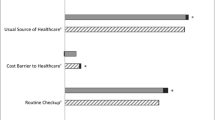Abstract
Despite increasing emphasis on disease prevention and health promotion, and ample evidence demonstrating the effectiveness of preventive services, such services are underutilized in the United States. The current trend of health care toward health maintenance organizations and other managed care systems opens the door, perhaps to more effective control of heart disease, cancers and other chronic diseases through preventive care. This warrants attention to the barriers/facilitators to the provision/utilization of preventive screening services in such settings. Overall goal of this study was to assess barriers/facilitators to the provision/utilization of preventive services in managed care organizations (MCOs). This was accomplished by a) identifying barriers/facilitators to the provision/utilization of three common preventive screening services (cholesterol screenings, mammograms, and Pap smears); and b) profiling typical MCO recipients of these three preventive screening services. A self-administered, mail questionnaire was used to obtain information from a national sample of 1,200 Directors of MCOs associated with preventive care. A total of 175 usable responses were received resulting in a 17.3 percent net response rate. The strongest barrier to the provision of all three screening services is the inability of them to generate short term savings for the MCO. Other barriers include high disenrollment rates, conflicting recommendations about effectiveness (for mammograms and cholesterol screenings), and patients' fears of getting a positive result (for mammograms and Pap smears). The improved health status as a result of early intervention, high consumer awareness (for mammograms and Pap smears), and long term savings are important facilitators to the provision/utilization of these screening services. Comparing barriers and facilitators across the three services shows the stronger barriers affecting the provision/utilization of mammograms. For all three screening services, typical managed care recipients are those in the high income groups with greater education levels. However, with the increasing enrollment of Medicaid beneficiaries into managed care, MCOs may find themselves selectively targeting these high risk low income and less educated individuals to receive the preventive screening services. Study findings should be useful to health planners, policymakers and researchers at all levels in their efforts to encourage and promote healthier lifestyle choices among U.S. residents. Future studies should address receipt of preventive services by Medicaid and Medicare beneficiaries in managed care settings.
Similar content being viewed by others
REFERENCES
U. S. Preventive Services Task Force. Guide to Clinical Preventive Services: An assessment of the effectiveness of 169 interventions. Baltimore, MD: Williams & Wilkins, 1989.
Garraway WM & Whisnant JP. The changing pattern of hypertension and the declining incidence of stroke. JAMA 1987; 258:214–7.
National Cancer Institute. 1987 annual cancer statistics review, including cancer trends, 1950–85. Washington, D.C.: Department of Health and Human Services, (Publication no. DHHS(NIH) 882789), 1988.
Shapiro S., Venet W., Strax, P. et al. Periodic screening for breast cancer. Baltimore, Md.: Johns Hopkins Press, 1988.
Pommerenke FA & Weed DL. Physician compliance: Improving skills in preventive medicine practice. Am J Fam Pract 1991;43:560–568.
Rosendahl I. Preventive care: A promise of opportunity. Drug Topics 1994; 138:42–52.
McGinnis JM & Foege WH. Actual causes of death in the United States. JAMA 1993; 270:2207–2212.
Lewis CE. Disease prevention and health promotion practices of primary care physicians in the United States. Am J Prev Med (supplement), 1988; 4:59–66.
McPhee SJ, Richard RJ, & Solkowitz SN. Performance of cancer screening in a university general internal medicine practice: Comparison with the 1980 American Cancer Society guidelines. J Gen Intern Med 1986; 1:275–81.
Woo B, Woo B, Cook EF, Weisberg M, & Goldman L. Screening procedures in the asymptomatic adult. JAMA 1985; 254:1480–84.
Dawson DA, Henderschott GE, & Bloom B. Trends in routine screening examinations. Am J Public Health 1987; 77:1004–1005.
Makuc DM, Freid VM, & Kleinman JC. National trends in the use of preventive health care by women. Am J Public Health 1989; 78:21–26.
Woolhandler S & Himmelstein DU. Reverse targeting of preventive care due to lack of health insurance. JAMA 1988; 259:2872–74.
Bloom B. Use of selected preventive care procedures United States 1982. DHHS publication no. (PHS) 86–1585, Series 10, No. 157. Hyattsville, MD: National Center for Health Statistics, 1986
Manning WG, Newhouse JP, Duan N. et al. Health Insurance and the demand for medical care: Evidence from a randomized experiment. The American Economic Review 1987; 77: 251–63.
Logsdon DN, Rosen MA, & Demak MM. The INSURE Project on Lifecycle Preventive Health Services. Public Health Rep 1982; 97: 308–17.
National Committee for Quality Assurance. HEDIS 2.5: Updated specifications for HEDIS 2.0. Washington, DC, Author, 1995.
Walters MJ & Ferrante-Wallace J. Lessons from nonresponse in a consumer market survey. J Health Care Marketing 1985;5:17–28.
National Committee for Quality Assurance. The Report Card Pilot Project Technical Report. Washington, DC, Author, 1995.
Parker SL, Tong T, Bolden S, & Wingo PA. Cancer Statistics, 1997. CA Cancer J Clin 1997; 47: 5–27.
Enthoven AC. Managed competition in health care and the unfinished agenda. Health Care Financing Review 1986; 105–119 (suppl).
Fletcher SW. Whither scientific deliberation in health policy recommendations. N Engl J Med 1997; 336:1180–1183.
Rights and permissions
About this article
Cite this article
Amonkar, M.M., Madhavan, S., Rosenbluth, S.A. et al. Barriers and Facilitators to Providing Common Preventive Screening Services in Managed Care Settings. Journal of Community Health 24, 229–247 (1999). https://doi.org/10.1023/A:1018765532250
Issue Date:
DOI: https://doi.org/10.1023/A:1018765532250




